+Unit3+大单元整体教学设计2022-2023学年人教版七年级英语上册+
- 格式:docx
- 大小:61.68 KB
- 文档页数:7
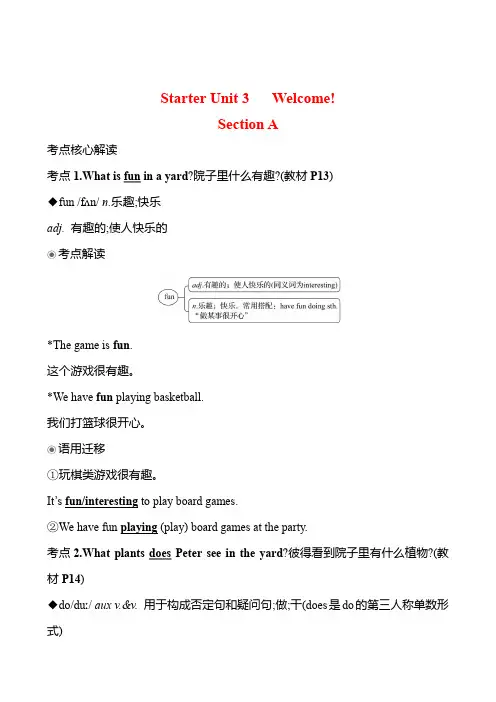
Starter Unit 3Welcome!Section A考点核心解读考点1.What is fun in a yard?院子里什么有趣?(教材P13)◆fun /fʌn/ n.乐趣;快乐adj.有趣的;使人快乐的考点解读*The game is fun.这个游戏很有趣。
*We have fun playing basketball.我们打篮球很开心。
语用迁移①玩棋类游戏很有趣。
It’s fun/interesting to play board games.②We have fun playing (play) board games at the party.考点2.What plants does Peter see in the yard?彼得看到院子里有什么植物?(教材P14)◆do/duː/ aux v.&v.用于构成否定句和疑问句;做;干(does是do的第三人称单数形式)考点解读*—Does he have a sister?他有一个姐姐吗?—Yes,he does. 是的,他有。
/ No, he doesn’t. 不,他没有。
*Let’s do it.让我们做这件事吧。
语用迁移①—Does Jane have a ping-pong bat?—______.But she has a baseball bat.A.Yes, she isB.Yes, she doesC.No, she isn’tD.No, she doesn’t②I have a basketball.(改为否定句)I don’t have a basketball.③Let’s do (做) our homework now.素养分层演练【A层基础练】Ⅰ.根据句意及首字母或汉语提示完成单词1.We should p lant more trees to protect the environment.2.Please be quiet. The baby(婴儿) is sleeping.3.I have a dog(狗).It’s black.4.My grandparents keep some ducks,chickens and rabbits(兔) on the farm.5.Dad, what are you doing in our yard(院子)?Ⅱ.用所给单词的适当形式填空1.Are those (that) her brothers?2.Some chicken (chicken) is on the brown table.You can have some.3.I like tomatoes(tomato).Do you like them?4.Hello, Jenny!These(this) are my brothers, Jack and Eric.5.There are many kinds of flowers(flower) in Mr Green’s garden.Ⅲ.根据汉语意思完成句子,每空一词1.这是我的一家。
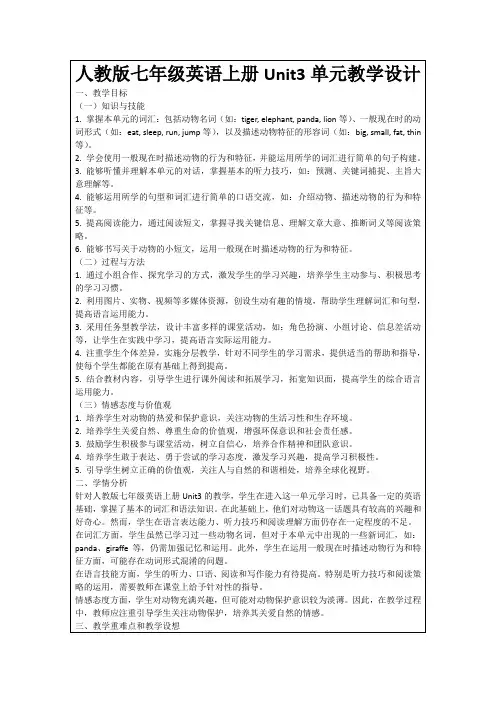
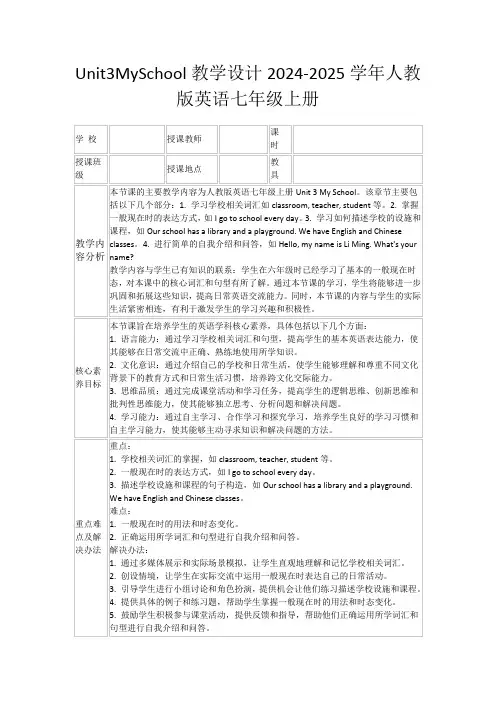
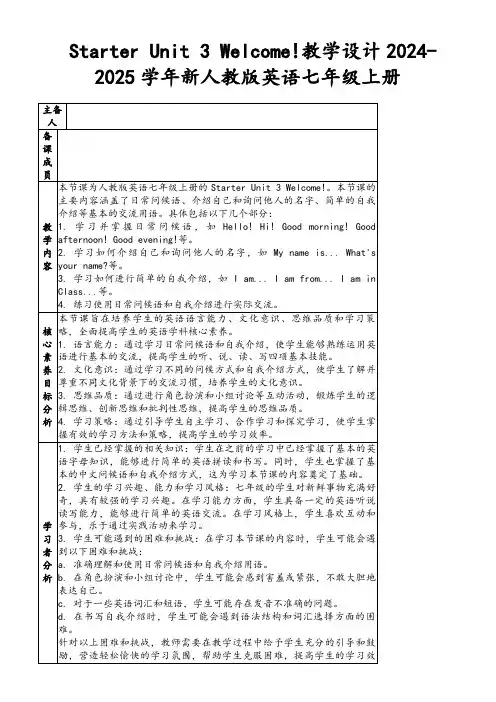
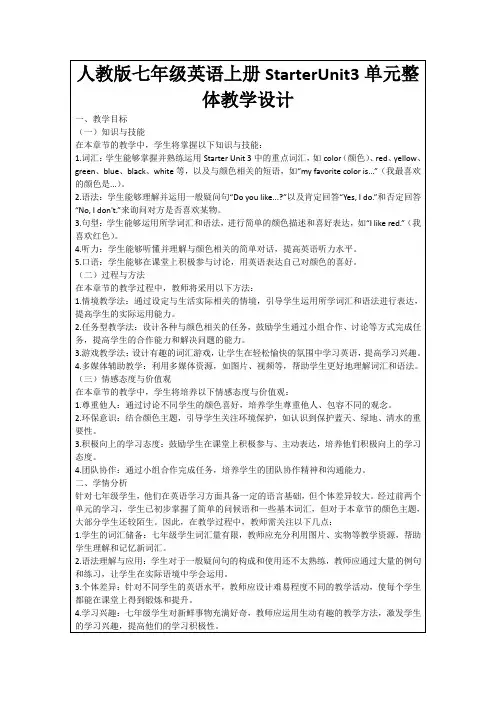
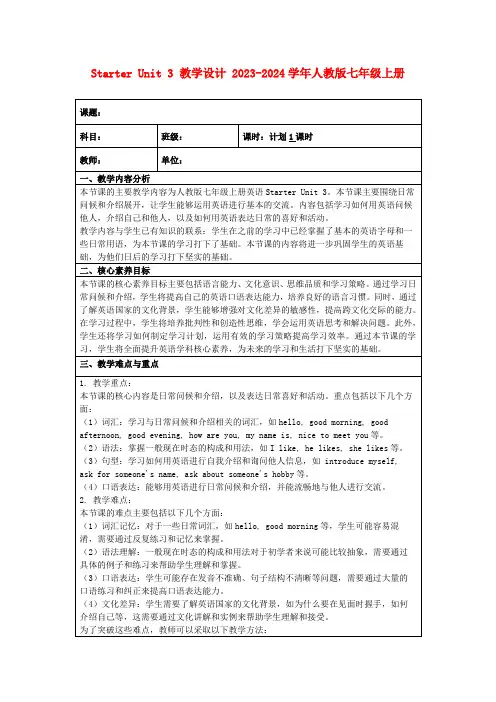
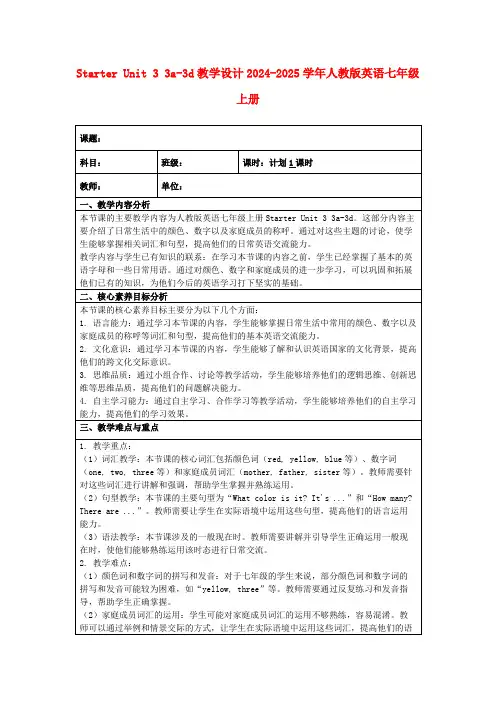
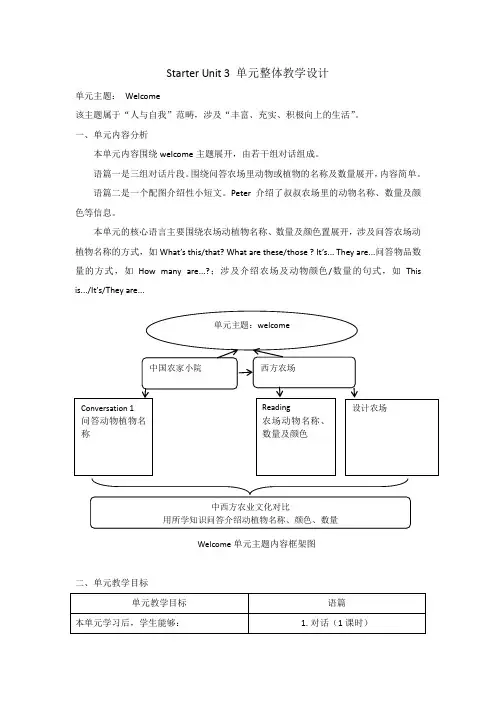
Starter Unit 3 单元整体教学设计
单元主题: Welcome
该主题属于“人与自我”范畴,涉及“丰富、充实、积极向上的生活”。
一、单元内容分析
本单元内容围绕welcome 主题展开,由若干组对话组成。
语篇一是三组对话片段。
围绕问答农场里动物或植物的名称及数量展开,内容简单。
语篇二是一个配图介绍性小短文。
Peter 介绍了叔叔农场里的动物名称、数量及颜色等信息。
本单元的核心语言主要围绕农场动植物名称、数量及颜色置展开,涉及问答农场动植物名称的方式,如What ’s this/that? What are these/those ? It ’s... They are...问答物品数量的方式,如How many are...?;涉及介绍农场及动物颜色/数量的句式,如This is.../It's/They are...
Welcome 单元主题内容框架图
二、单元教学目标
单元教学目标
语篇 本单元学习后,学生能够: 1. 对话(1课时) 单元主题:welcome 中国农家小院 西方农场 Conversation 1
问答动物植物名称
Reading 农场动物名称、数量及颜色
设计农场 中西方农业文化对比 用所学知识问答介绍动植物名称、颜色、数量
1.得体问答农场动植物名称
2.得体问答农场动物名称、颜色及数量 2.配图短文(1课时)
3.对话(1课时)
3.会读五个元音字母的闭音节音素,总结元
音字母的闭音节发音规律。
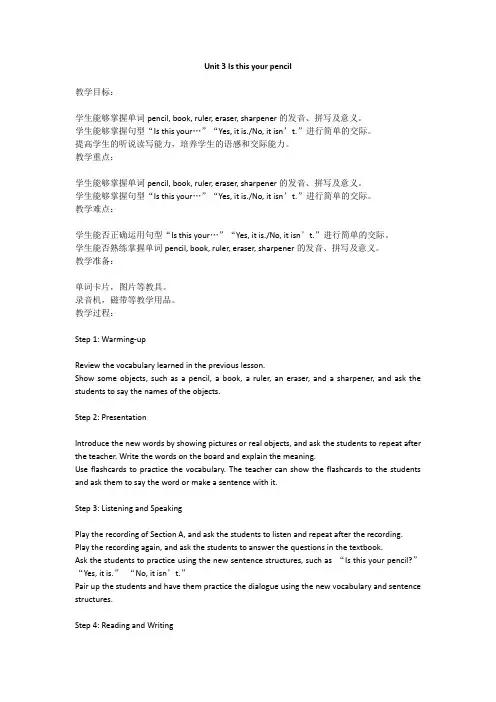
Unit 3 Is this your pencil教学目标:学生能够掌握单词pencil, book, ruler, eraser, sharpener的发音、拼写及意义。
学生能够掌握句型“Is this your…”“Yes, it is./No, it isn’t.”进行简单的交际。
提高学生的听说读写能力,培养学生的语感和交际能力。
教学重点:学生能够掌握单词pencil, book, ruler, eraser, sharpener的发音、拼写及意义。
学生能够掌握句型“Is this your…”“Yes, it is./No, it isn’t.”进行简单的交际。
教学难点:学生能否正确运用句型“Is this your…”“Yes, it is./No, it isn’t.”进行简单的交际。
学生能否熟练掌握单词pencil, book, ruler, eraser, sharpener的发音、拼写及意义。
教学准备:单词卡片,图片等教具。
录音机,磁带等教学用品。
教学过程:Step 1: Warming-upReview the vocabulary learned in the previous lesson.Show some objects, such as a pencil, a book, a ruler, an eraser, and a sharpener, and ask the students to say the names of the objects.Step 2: PresentationIntroduce the new words by showing pictures or real objects, and ask the students to repeat after the teacher. Write the words on the board and explain the meaning.Use flashcards to practice the vocabulary. The teacher can show the flashcards to the students and ask them to say the word or make a sentence with it.Step 3: Listening and SpeakingPlay the recording of Section A, and ask the students to listen and repeat after the recording. Play the recording again, and ask the students to answer the questions in the textbook.Ask the students to practice using the new sentence structures, such as “Is this your pencil?”“Yes, it is.”“No, it isn’t.”Pair up the students and have them practice the dialogue using the new vocabulary and sentence structures.Step 4: Reading and WritingAsk the students to read the dialogue in Section A and try to understand the meaning.Ask the students to write a short paragraph about the objects they have in their school bags using the new vocabulary and sentence structures they have learned.Step 5: Review and AssessmentReview the new vocabulary and sentence structures with the students by asking them to say the words and make sentences with them.Assess the students’understanding of the new vocabulary and sentence structures by asking them to complete some exercises in their textbook or workbook.Step 6: HomeworkAssign some homework exercises that reinforce the new vocabulary and sentence structures, such as writing a short paragraph about the objects they have in their school bags or doing some fill-in-the-blank exercises.。
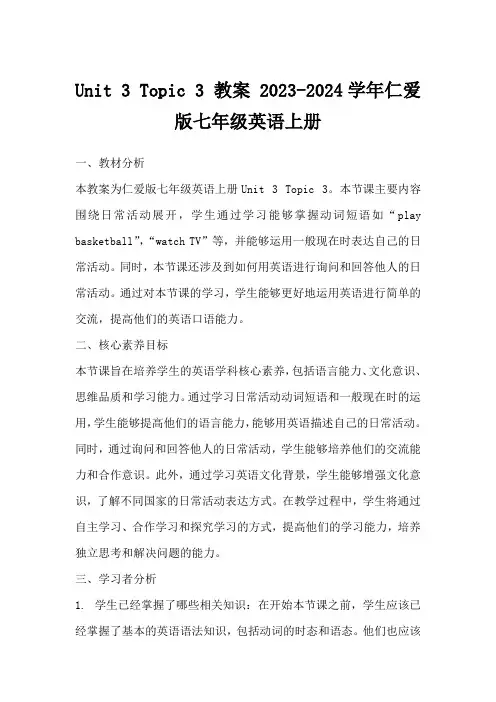
Unit 3 Topic 3 教案 2023-2024学年仁爱版七年级英语上册一、教材分析本教案为仁爱版七年级英语上册Unit 3 Topic 3。
本节课主要内容围绕日常活动展开,学生通过学习能够掌握动词短语如“play basketball”,“watch TV”等,并能够运用一般现在时表达自己的日常活动。
同时,本节课还涉及到如何用英语进行询问和回答他人的日常活动。
通过对本节课的学习,学生能够更好地运用英语进行简单的交流,提高他们的英语口语能力。
二、核心素养目标本节课旨在培养学生的英语学科核心素养,包括语言能力、文化意识、思维品质和学习能力。
通过学习日常活动动词短语和一般现在时的运用,学生能够提高他们的语言能力,能够用英语描述自己的日常活动。
同时,通过询问和回答他人的日常活动,学生能够培养他们的交流能力和合作意识。
此外,通过学习英语文化背景,学生能够增强文化意识,了解不同国家的日常活动表达方式。
在教学过程中,学生将通过自主学习、合作学习和探究学习的方式,提高他们的学习能力,培养独立思考和解决问题的能力。
三、学习者分析1. 学生已经掌握了哪些相关知识:在开始本节课之前,学生应该已经掌握了基本的英语语法知识,包括动词的时态和语态。
他们也应该能够使用一些日常的英语词汇来描述自己的简单信息和日常活动。
此外,学生应该具备一定的听、说、读、写的能力,能够进行简单的英语交流。
2. 学生的学习兴趣、能力和学习风格:根据对学生的了解,他们对实用性强的英语知识更感兴趣,希望能够用英语进行实际的交流。
在学习能力方面,大部分学生能够跟上教学进度,但程度不同的学生对于新知识的理解和应用能力有所差异。
在学习风格上,一部分学生喜欢通过视觉学习,另一部分学生则更倾向于通过听觉或动手操作来学习。
3. 学生可能遇到的困难和挑战:在本节课的学习中,学生可能会遇到以下困难和挑战:一是对于一般现在时的理解和运用,部分学生可能对此时态的用法混淆不清;二是对于日常活动词汇的掌握,一些学生可能对这些词汇的英文表达不熟悉;三是如何将所学知识运用到实际的交流中,部分学生可能在实际口语交流中感到紧张或不知如何表达。
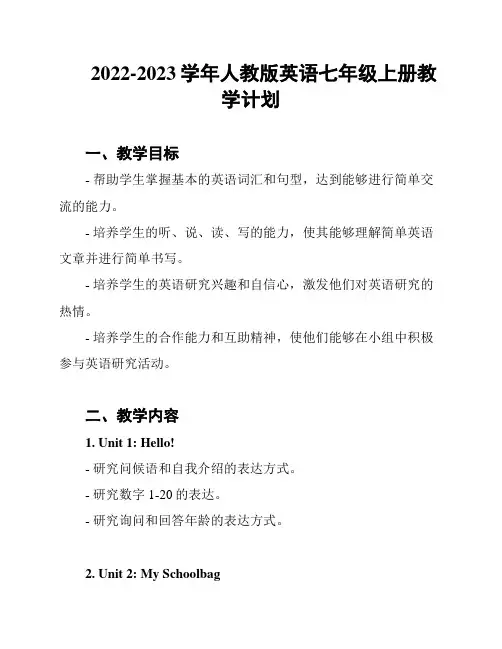
2022-2023学年人教版英语七年级上册教学计划一、教学目标- 帮助学生掌握基本的英语词汇和句型,达到能够进行简单交流的能力。
- 培养学生的听、说、读、写的能力,使其能够理解简单英语文章并进行简单书写。
- 培养学生的英语研究兴趣和自信心,激发他们对英语研究的热情。
- 培养学生的合作能力和互助精神,使他们能够在小组中积极参与英语研究活动。
二、教学内容1. Unit 1: Hello!- 研究问候语和自我介绍的表达方式。
- 研究数字1-20的表达。
- 研究询问和回答年龄的表达方式。
2. Unit 2: My Schoolbag- 研究物品名称的表达。
- 研究询问和回答物品归属的表达方式。
- 研究物品的数量表示方法。
3. Unit 3: My Family- 研究家庭成员的称呼。
- 研究询问和回答家庭成员的表达方式。
- 研究家庭成员的介绍和简单描述。
4. Unit 4: My Day- 研究一天的时间表达。
- 研究描述日常活动和研究安排的表达方式。
- 研究简单的日常活动对话。
5. Unit 5: Happy Birthday!- 研究问候和寿诞祝福语。
- 研究询问和回答生日日期的表达方式。
- 研究描述生日派对和礼物的表达。
三、教学方法- 采用任务型教学法,让学生在实际情境中运用所学知识进行交流和实践。
- 进行小组合作研究,鼓励学生之间相互协助、共同探讨问题。
- 利用多媒体教学手段,如图片、音频、视频等,增加教学内容的生动性和趣味性。
四、教学评估- 通过课堂表现、小组合作、作业和测验等方式对学生的研究情况进行评估。
- 鼓励学生参与课堂讨论和互动,提高口语表达和听力理解能力。
- 针对学生的研究困难进行差异化教学,促进全体学生的个体发展。
五、教学资源- 人教版《英语》七年级上册教材和练册。
- 多媒体课件、图片、音频和视频资源。
- 教学辅助工具,如黑板、白板、投影仪等。
六、教学安排- 每周安排4个教学课时,每节课时为40分钟。
邵东市第三届中小学青年教师教学竞赛教学设计表组别:初中科目:英语教学片段标题:七上Unit3 Is this your pencil? Section A(1a-1c)学情分析:As students from Grade 7, this is the first term of their junior school. Most of them are interested in English and they are really active. But they have small vocabulary. For the English ability,they have learned the sentence pattern “This is my sister.” And in this unit they are going to practice the general question sentence pattern.So,in this period the activities will be designed to match their foundation.教学目标:Language competence:1. Students will be able to master the new words:pencil、 eraser 、pencil box、 schoolbag 、dictionary2. Students will be able to use “my”“mine”“her”“hers”“his”correctly.3. Students will be able to master the following sentence patterns:Is this/that....? Yes,it is/No,it isn't.Are these/those.... ? Yes,they are/No,they aren't.Learning ability:By the end of this class,Ss’ speaking and listening skills will be improved, and their vocabulary will be enlarged.Thinking quality:After the “find the owner”activity, Ss will realize the importance of taking good care of their own things and form the good habit;Cultural awareness:Help Ss develop the good quality of returning the lost things and helping others.教学重难点:Key Points:1. Enable Ss to use Yes/No questions to identify the ownership correctly and answer the questions;2. Enable Ss to improve their listening ability to apply listeningstrategies, like prediction and shorthand;3. Get Ss to speak English with the right pronunciation and intonation. Difficult Point:Make Ss understand the differences between the nominal possessive pronouns and the adjective possessive pronouns and use them correctly.教学过程:Step1.Warming-upPlay a game to check the preview of the words.Step2.Presentation and practice1.Present the new words:schoolbag, book,eraser,pencil,dictionary,pencil box.2.Game: What is missing?3.Match the words with the things in the picture in 1a.4.Present the new sentence pattern:A:Is this/that your ...?B: Yes, it is.It’s mine./No, it isn’t. It’s his/hers.A:Are these/those your ...?B:Yes, they are. They’re mine./No, they aren’t. They’re hers/his.5.Game: Ask and Answer.Choose a number, and make a conversation about the picture behind it with the target sentences.6.Quick response: Look at the sentences on the slides and say the sentence with similar meaning.Step3.Listening practice1.Listen and number the conversations in 1b.2.Check the answers.Step4.Group workLet’s find out the owner!Rule: Find out the owners of the things with the sentences learned in this class by asking questions.Step5.Emotional EducationYou should take care of your own things!Step6.SummarySummarize the words and sentences from this class.Step7.HomeworkLevel1:Copy the sentence patterns for once.Level2:Make 3 conversations by using the sentences we learned today. Blackboard design:Teaching Reflection:。
Unit 3 Is this your pencil?(Section A 1a-1c)教学目标:学生能够用英语表达物品的所有者。
学生能够用英语询问并回答物品的所有者。
学生能够掌握物主代词my, your, his, her, its等。
教学重点:学生掌握物主代词的用法和区别。
学生能够在日常生活中正确运用所学的物主代词。
教学难点:学生能够正确运用物主代词进行交流。
学生能够从日常生活中学习如何正确运用物主代词。
教学准备:教材、单词卡片、黑板、投影仪。
教学过程:Step 1. Warming upReview the greetings from the previous lesson and have the students practice greeting each other in pairs.Hold up a pen and ask the students, "What's this in English?" Write the word "pen" on the board and have the students repeat it.Step 2. Vocabulary introductionIntroduce the vocabulary words for pen, pencil, eraser, ruler, and book using flashcards or real objects.Have the students practice saying the words and spellings in groups.Step 3. Listening and speaking practicePlay an audio recording of a native speaker saying the vocabulary words and have the students repeat the words.Use flashcards or real objects to practice asking and answering questions about the ownership of objects using the target phrase "Is this your pencil/pen/eraser/ruler/book? Yes, it is./No, it isn't. It's his/her/its/my pencil/pen/eraser/ruler/book."Have the students work in pairs to ask each other questions about the ownership of objects using the target phrase.Step 4. Vocabulary consolidationHave the students practice saying the vocabulary words and spelling in groups or pairs.Use pictures or real objects to quiz the students on their knowledge of the vocabulary words.Step 5. Extension activityHave the students practice asking and answering questions about the ownership of objects using the target phrase "Do you have a pencil/pen/eraser/ruler/book? Yes, I do./No, I don't."Have the students work in pairs or small groups to practice the new question and answer structure.Step 6. HomeworkAssign the students to write a short paragraph about their favorite school supplies using the vocabulary words and target phrases learned in class.。
七年级英语单元整体教学设计Unit 3 Is this your pencil ?一、大概念:【单元主题】Things in the classroom该主题属于“人与自我”范畴,涉及“自我认识,自我管理,自我提升”。
话题属于确认物品的所属关系。
二、基于“大概念”的教学目标设计1.课标说明根据《义务教育英语课程标准》2022年版,要关注课程的核心素养,注重学科育人功能。
课程标准对七年级学生的要求:能识别口语语篇中说话者的语调变化,判断意义的变化;能在教师指导下进行简单的角色扮演;围绕相关主题,用简短的表达方式进行口头交流,完成交际任务;能听懂发音清晰、语速较慢的简短口头表达,获取关键信息;能根据口头交际的具体情境,初步运用得体的语言形式,表达自己的观点;能选用正确的词语、句式和时态,通过口语或书面语篇描述、介绍事物,表意清晰,话语基本通顺。
2.单元内容分析本单元由Section A和Section B组成。
Section A部分以听说为主,包括三个对话语篇,都是有关课间教室内的场景,谈论教室内常见物品的有关话题。
同时兼顾语法学习:学习形容词性物主代词和名词性物主代词,询问及辨认物品的所有者的句式,即单复数形式的一般疑问句(Is this/that...Are these/those...)及简略回答(It’s...They’re...)。
Section B以读、写为主,包括一个听力语篇和一个阅读语篇。
话题语境在Section A的基础上进行了拓展,主要围绕在学校失物招领处认领物品的情景,拓展了相关词汇和主要句型。
让学生进一步体会目标语言在真实语境中的运用,初步掌握写寻物启事和失物招领的简单方法。
教学重点:使用含有指示代词的一般疑问句来询问物品的所有者,学会使用表示常用学习物品的基本词汇和名词性物主代词来确认物品的所有者。
教学难点:理解名词性物主代词和形容词性物主代词的区别和用法。
Things in the classroom教室内校园失物招领处3.学生情况分析初一学生有着极强的求知欲和表现欲,根据他们的心理特点,在课堂上教师多以表扬为主,提升他们的自信心,激发英语学习的兴趣,鼓励他们大胆说,积极做,努力讲。
另一方面,他们小学都有一定的英语基础,这一单元的话题对他们也并不陌生,谈论起来也相对较轻松,但是他们的英语水平参差不齐,所以教师会在课堂上分层实施教学任务,力求人人参与,人人都有事做,切实提高课堂效率。
4.素养目标语言能力:能听懂、会说与学习用品和个人物品相关的词汇和句型;能围绕学习用品相关主题,运用物主代词、指示代词和一般疑问句,与他人进行日常交流,语音、语调、用词基本准确,表达比较连贯。
文化意识:了解失物招领的小常识;学会爱惜自己的学习用品,并养成照看好自己物品的好习惯,养成拾金不昧的优秀品质。
思维品质:能提取、整理、概括失物招领和寻物启事的关键信息、主要内容,判断各种信息的异同和关联,并根据上下文进行预测。
学习能力:能够通过谈论身边的事物激发学生学习英语的兴趣和表达物品所属关系的学习目标;能积极主动参与学习活动,注意倾听,积极与他人合作,共同完成学习任务。
三、基于“大任务”的教学活动设计(共五课时)课时教学目标学习活动效果评价第一课时Section A 1a-2d 1.掌握并运用有关学习用品的名词以及单复数;2.能听懂并运用一般疑问句(Yes/Noquestions andshort answers)来确认物品的所有者。
1.学生读1a图理解语境,并找出图中的学习用品,并在教师的引导下借助自然拼读学习school things 的单词,加深学生对单词的理解和记忆;2.学生在教师的引导下听完整录音,整体感知对话语境,核对自己的预测,并跟读、分角色扮演,模仿语音、语调;3.两人一组运用目标语言谈论教室里物品的所有者。
教师观察学生能否参与互动与交流,主动分享个人对该主题已有的知识、经验,并根据需要调整提问方式,进行追问或给予鼓励。
教师观察学生听力情况,根据学生表现给予指导反馈。
教师根据不同能力水平学生朗读对话的情况,给予指导或鼓励。
第二课时Section A Grammar 1.正确使用指示代词this/that/these/those;2.正确使用名词性物主代词,能够理解其和形容词性物主代词的区别和用法;3.能够在小组内流利对话来谈论物品的所属关系。
1.通过图片、例句和练习题理解并掌握指示代词this/that/these/those的用法;2.学生认真阅读Grammar Focus ,找出语言结构或语义上存在的疑问,并讨论解决;3.学生在教师的引导下总结be动词与指示代词保持一致this/that用is, these/those用are;学生总结一般疑问句的基本结构以及简答;4.小组内练习对话。
观察学生能否正确地使用指示代词和物主代词谈论物品的所属关系;观察小组讨论和呈现,把握学生对重点语言表达的学习和内化情况。
第三课时Section B 1a-1e 1.学习并掌握Section B的单词:baseball,watch,computer, game,ID card;2.进一步巩固1.学生匹配1a的单词和图中物品并运用图中物品,两人一组创编新对话;2.学生预览信息并对所听内容预测,听的过程中捕捉并记录关键性信息;3.通过Role-play, 学生两人一组,角色扮演,创编新对话并展示。
观察学生辨认物品时使用语言是否准确,把握学生内化所学内容和语言的情况。
Is this/that your...? Are these/those your...?第四课时Section B 2a-2c 1.能够读懂并理解失物招领和寻物启事;2.能够总结失物招领和寻物启事的格式以及三要素;3.培养拾金不昧,助人为乐的品质。
1.学生快速阅读2b,圈出丢失物品;2.学生仔细阅读并观察标题,区分Found 和Lost;3.通过Group work 谈论Found 和Lost的写作要点和格式;观察学生能否运用自上而下的阅读,先整体阅读,再搜索关键词,抓住文章的关键信息;关注学生在小组讨论和班级展示中是否涵盖了文中包含的内容,教师根据情况给予必要的指导和反馈。
第五课时Section B 3a-3c 1.能够掌握Found 和Lost格式和写作特点;2.能够为自己或者帮助他人写Found 和Lost。
1.完成3a,总结Found 和Lost内容特点和格式;2.学生写一则自己的失物招领或寻物启事(请两位同学在黑板上写);3.师生共同评价黑板上的短文,从信息的完整性、格式、目标语言的运用、书写规范等方面评价;4.学生两人互评修改,老师进行个别指导;5.学生大声读出他们的作文,与全班同学分享。
作文评价标准:观察短文题目是否符合要求(Lostor found);观察失物招领格式是否正确?有无文末落款?观察是否正确使用相应的目标语言?是否有联系方式?观察在拼写、语法和标点方面是否都正确?观察书写是否规范?(学生自评,互评和教师评价)四、基于“大进阶”的教学评价设计1.假如你是七年级二班的学生Alan Green,你在操场(playground)捡到一个蓝色的书包。
请你写一则失物招领贴在公告栏,方便失主联系你,你的电话是288-1532。
________________________________________________________________________________________________________________________________________________________________________________________________________________________________________________________________________ 2. 假如你是王欣,你在学校操场丢了一块红色的手表,它对你很重要。
你必须找到它。
请根据提示写一则寻物启事,说明情况。
你的电话号码是:7641-6779。
________________________________________________________________________________________________________________________________________________________________________________________________________________________________________________________________________ 【写作自评表】请使用下面的表格完成自评和修改。
依据每个问题进行自查,看看结果是“是”还是“否”。
如果是“否”,请记录如何修改以完善自己的写作。
问题是否如果为“否”,如何改进?你的短文题目是否符合要求(Lost or found )? 你的失物招领格式是否有文末落款? 你的失物招领是否包含联系方式?你的短文在拼写、语法和标点方面是否都正确?【写作互评表】请一位同伴阅读你写的短文并完成下面的表格。
之后,请你根据同伴的反馈进一步修改和完善你的短文。
评价指标得分评分标准短文题目是否符合要求(Lost or found )? 5=Excellent 4=Good 3=Acceptable2=Needs Improvement失物招领格式是否有文末落款? 失物招领是否包含联系方式?短文在拼写、语法和标点方面是否都正确?五、基于“大单元”的教学设计反思本单元教学设计过程中最重要的部分就是建立各个语篇之间的逻辑联系,重新整合教学思路,建构单元主题框架,找出单元的大概念,统领整个单元。
大概念可以帮助教师准确把握学科教学的重点和本质。
教师可以借助大概念统领学科知识,让学生学习最重要的内容,有效定位教学价值,防止备课、授课时偏离教学目标。
在“教-学-评”一体化设计中,还要注意教学评价应充分关注学生的个体差异,考虑学生的认知水平和个性特点等,选用合理的评价方式,注重对学生学习过程、认知过程和成长过程的评价,帮助每个学生在原有基础上实现发展。